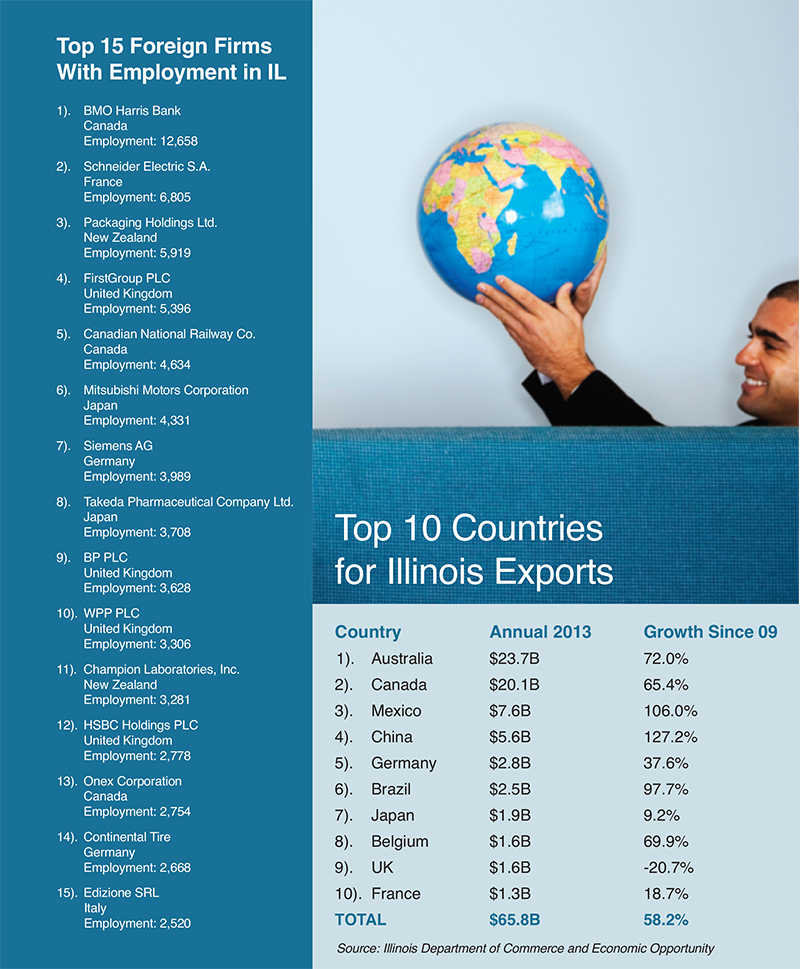The Foreign Factor
International investments and exports could be the key to Illinois’ economic success.
By Carolyn Kmet | Summer 2015

When you think about the global economy—who leads, who trails, and where
billions of dollars of goods and services are coming from—Illinois probably doesn’t spring readily to mind. And yet, Illinois has the 19th largest economy in the world.
In 2013, the state exported more than $65.8B of goods and services, and direct exports accounted for nearly 10 percent of gross state product, according to the Illinois Department of Commerce and Economic Opportunity (IDCEO). Looking at the foreign factor from a different angle, majority-owned U.S. affiliates of foreign firms employ more than 270,000 people in Illinois, which means continued export and foreign direct investment (FDI) are key to Illinois’ economic future.
“FDI is a big job generator for Illinois, and it’s also a big job retainer because of larger foreign companies locating their global corporate headquarters in Illinois,” says John DeBlasio, director of the Office of International Trade and Investment with the IDCEO. “The predominant flow of acquisition money is coming from large corporate money from around the world.”
According to a report released by SelectUSA, a federal initiative that promotes, facilitates and encourages business investment in the United States, almost 500 FDI projects have been announced in Illinois since 2003, representing $18.93B in capital investment.

Why Illinois? For starters, the state offers a higher skilled labor force, a very strong transportation infrastructure, and an ecosystem around advanced manufacturing. In fact, almost 40 percent of the 270,000-plus jobs created by foreign-owned companies are in the manufacturing sector.
“Foreign direct investment certainly provides much needed infusions of capital,” explains Donna Lubrano, an adjunct professor of international business. She adds that FDI typically spurs “sourcing of local vendors and suppliers, domestic innovation, and helps improve technology and manufacturing best practices.”
What’s more, Lubrano explains that a well-structured FDI package can provide small and minority business owners with new customers and revenue streams, and new opportunities to drive growth and profitability. The effects, theoretically, should ripple through the rest of the economy in the form of new jobs, increased disposable income, increased spending and, of course, increased tax revenue for the state.
The IDCEO’s main goal, says DeBlasio, is to maintain Illinois as one of the top five destinations for FDI by identifying trends in the global marketplace. “We haven’t been as competitive as other states. We don’t have as much of a presence doing targeted marketing around the world," he admits, "but we intend to do more of that because it will pay off in more jobs for Illinois. For example, we have a very strong advanced manufacturing sector. That sector matches up well with other advanced manufacturing clusters such as in the Midlands (UK), rural Germany and Northern Italy. What we do is target median-sized businesses in those areas and then encourage them to build their U.S. presence here in Illinois.”
Another IDCEO strategy is to target and entice companies specifically in Illinois’ strongest sectors. “Illinois has a very strong advanced manufacturing sector, an emerging tech sector, and a strong financial services sector, so we recruit businesses from around the world in those sectors to come here. They’ll find more clients, easy access to suppliers, and the human capital is readily available,” says DeBlasio.
It’s not just about bringing foreign companies to Illinois, though; it’s about getting Illinois companies to export their products and services. With 80 percent of the world’s purchasing power existing outside the United States, economic growth in Illinois can benefit hugely from trade expansion.
“Your market goes from 300 million Americans to 7 billion people around the world,” DeBlasio explains. “Illinois businesses tend to do business locally, but if they exported, they would have a much bigger pool to play in. Expanding into Canada alone grows a business’ market potential by 10 percent.”
Since 2009, Illinois exports have increased by $24.2B, or 58 percent, outperforming the national average of 50 percent, according to the IDECO. Brian Butler, director of the Illinois International Trade Center at NORBIC/Alliance for Illinois Manufacturing, attributes this, in part, to a recessionary economy in 2008 and 2009 that forced businesses to look for new markets.
“When Illinois businesses export overseas, the state sees more revenue and increased job creation, and becomes better positioned to compete globally,” Butler explains, pointing out that exports support approximately 1.7 million jobs in Illinois, which has become the largest exporting state in the Midwest, and the fifth largest exporting state in the country.
Even so, many Illinois businesses shy away from exporting. “A lot of manufacturers are just afraid; exporting is kind of intimidating,” says Pam McDonough, president and CEO of the Alliance for Illinois Manufacturing.
Indeed, a lack of experience in exports and international markets, a lack of access to trained personnel, and a lack of knowledge relating to how and where to get started are pretty big hurdles for businesses to get over.
But hope isn't lost. “Take advantage of low/no cost resources such as the 12 Illinois International Trade Centers, the Illinois Overseas Trade and Investment Office, the Chicago Export Assistance Center and the International Business Council of the Illinois Chamber of Commerce. And then analyze the best countries for their particular products and services and attend local international trade presentations,” Butler advises.
McDonough adds that there are more resources available to companies looking to export than ever before. “For example, we walk businesses through an export readiness exercise and try to make them think strategically about what markets they should be in based on whether their competition is there, if it’s an emerging market, or if it’s a good fit,”
McDonough explains. She says grants are available to offset travel costs associated with trade missions, organizations exist specifically to help Illinois businesses identify and connect with in-country distributors, and tools are available to enable businesses to identify where their competitors are selling and what their transportation costs are.
“We live in a global economy,” says McDonough. “If Illinois’ businesses and manufacturers don’t consider export opportunities, they’re missing out.”